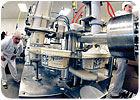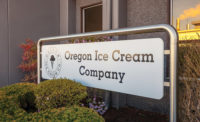
For most men, a midlife crisis means a new Porsche or Harley in the garage. For Tom Gleason, it meant a new Tetra Pak Hoyer extruded novelty machine.
Well, maybe that isn’t exactly how it happened. But Gleason did get into the ice cream business as a career change, and it’s meant reinventing his new company almost from day one. This journey of a dozen years and counting has brought some high-tech frozen dessert-making equipment to this one-time old-school processor in Eugene, Ore., making the Oregon Ice Cream Co. a leader in the world of natural and organic treats.
“With organic, our ingredient costs are nearly double the cost of conventional ice cream,” Gleason, the company’s president and chief executive officer, says in discussing the challenges of organic food manufacturing. “What we’re banking on is, over time, as organic grows, costs will drop as processors get more efficient.”
Meanwhile, the company has beefed up its infrastructure and R&D to make unique products not only for its own brands, but for a growing list of contract manufacturing clients eager to break into the organic market. In 2004, Oregon Ice Cream invested $6 million in European extrusion technology that can make high-end frozen novelties out of ice cream and, thanks to another technological breakthrough, sorbet. Gleason says his is the only company outside of the two large national players to own such equipment.
Investments like this mean the diminutive Oregon Ice Cream, which began life in 1938 as commodity half-gallon maker Dutch Girl, can crank out 14,000 bars every hour – treats that have fast become best-sellers in natural and organic food marketplace.

Welcome extrusion
The company declines to disclose the exact source of its organic raw milk. However, its “scorecard” on the Web site of the Cornucopia Institute, an organic watchdog group, offers some hints. Oregon Ice Cream receives an excellent rating for its organic commitment, including a 95 for pasture compliance out of a total score of 1,100 points, or “four cows,” for 12 criteria monitored by the group.Milk is HTST processed and transformed into bases for the hundreds of SKUs of products manufactured here, from packaged ice cream in an array of sizes to stick and sandwich novelties.
The apex of frozen dessert technology at the Eugene facility is its state-of-the-art Hoyer extrusion lines, part of $20 million in improvements that have involved equipment and real estate to accommodate demands on the growing business.
Going full tilt to fill an order for Costco during DFR’s recent visit, one of these massive lines makes sticks novelties and wraps them a dozen at a time. The continuous freezer feeds ice cream to the line in the shape of the finished bar. A wooden stick is shot with compressed air into the firm ice cream a split second before the bar is cut with a double wire, leaving a distinctive ridge effect on the surface of the bar.
The bars then head into the hardener, where they’re kept for a time at temperatures as low as -50 degrees F. The hardener can hold up to 800 plates, with three bars per plate, on spiral accumulators.
Emerging from the hardener, the frozen bars are loosened from the plates by hand, then are mechanically lifted in rows of 12 and placed in their wrappers before they’re manually boxed for casing and shipment. Gleason explains these bars are meant to be dipped to order in a variety of coatings at the foodservice level.
Meanwhile, another Hoyer extrusion line is busy making Juliettes, 100-calorie ice cream sandwiches that are part of the Julie’s Organic lineup. Square wafers fit into slots on the conveyor; they’re topped with a square of extruded ice cream and trimmed off, then finished with another wafer on top and sent into the hardener. The diminutive sandwiches are wrapped and boxed, then crated up and whisked away to storage pending shipment to customers.
Gleason explains why Oregon Ice Cream opted to make its novelties by extrusion rather than molding: “Extrusion technology improves the texture of high- and low-butterfat ice cream items that have lower overrun as the ice cream is extruded at a lower temperature than a fill from a molded system, 19 to 22 degrees. Then the ice cream is immediately frozen in a -45 to -50 degree spiral before coating is applied. This colder process keeps the ice cream from forming ice crystals and makes the product creamier.”
Though an extrusion system costs more to operate compared to a Vitaline-type system, the advantages are many. “The other key flexibility is that creating new shapes only requires one forming head in the shape of the item versus thousands of new molds, making it much easier and cost-effective to adapt shapes and styles,” Gleason says. “The maintenance expense is higher on the extrusion machine due to the many more synchronized ‘stations’ and electronics used to control the advance automation.”
With the extrusion machines on the perimeter of the plant floor, moveable lines are set up as required in the center to fill containers like pints, quarts and scrounds. During this particular visit, a scround line is filling 48-ounce packages of Alden’s Ice Cream, one of the company’s newest products that has really taken off in the marketplace.
“We thought it was just the right size for families,” Gleason says. “Plus, for organic, we’re trying to keep the price point reachable.”

Keeping pace
As product development has progressed and demand has increased, keeping new levels of production reachable has meant making constant upgrades to the half-century-old plant. “Since 1997, when we had only one production line for packaged ice cream and produced about 3 million gallons annually, we have gone through four plant expansions,” Gleason says. “Now we’re manufacturing over 10 million gallons, plus 60 million novelty units.”Working with plant personnel is the R&D team, which develops not only new products but the processes by which they can be manufactured. “We have developed innovative ways to manufacture a variety of ‘firsts,’” Gleason says. “For example, we developed technology to extrude fruit sorbet – something we have not seen anywhere else in the world.”
As the company continues to grow, it will invest in the necessary equipment; Gleason preferred to keep details of any future projects confidential.
Investment of time and resources is also made to ensure employee safety. “We have a complete safety team that included a safety manager and personnel from all departments of our plant operations that has input on these issues,” Gleason explains. “Management fully supports the programs and recommendations.”
On the food safety side, sanitation is key to plant operations; the company employs extensive HACCP and sampling programs, plus environmental swabbing reporting.
And beyond high marks from Cornucopia for its commitment to organic standards, Oregon Ice Cream strives to ensure the integrity of all components of the manufacturing process. “We utilize many auditing tools in relation to receiving, pathogen swabbing and inspection of inbound materials,” Gleason says. “Due to being an organically certified producer that produces organically certified products, we have the luxury on the organic side of inspectors by our certifiers and others that inspect the supply sources of much of what we purchase.”
As organics show staying power as a niche market successfully working its way into the mainstream, Oregon Ice Cream is poised to be a leader in its segment – a little giant in the shadow of a contracting industry. Staying a step ahead with its manufacturing processes and product development is giving the company a crucial edge with its customers.

At A Glance
Oregon Ice Cream Co.Location: Eugene, Ore.
Year opened: 1956
Size: 68,000 square feet
Number of employees: 150 (up to 200 in peak season)
Products made: 3- and 4-gallon tubs, 56 ounce, 5 quart, 48 ounce, quarts, pints, small cups (3 to 10 ounces), extruded bars and sandwiches.
Total processing capacity: 12 million gallons packaged, 80 million novelties.
Pasteurization: HTST, two systems.
Filling/packaging lines: Five (three packaged ice cream, two Hoyer extruded novelty lines).
Storage capacity: Freezer storage 2,500 pallet spaces.
Extras
Bloomfield Bakers
Double H Plastics
Ecolab
Firmenich
Gram Equipment
Hi-Speed
Huhtamaki
Mettler-Toledo Safeline
Tetra Pak Hoyer
Vanlab
